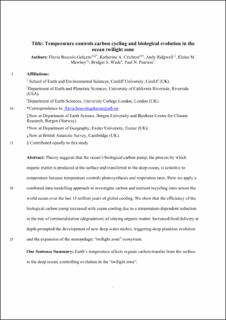| dc.contributor.author | Boscolo-Galazzo, Flavia | |
| dc.contributor.author | Crichton, Katherine A. | |
| dc.contributor.author | Ridgwell, Andy | |
| dc.contributor.author | Mawbey, Elaine M. | |
| dc.contributor.author | Wade, Bridget S. | |
| dc.contributor.author | Pearson, Paul N. | |
| dc.date.accessioned | 2021-08-04T09:39:42Z | |
| dc.date.available | 2021-08-04T09:39:42Z | |
| dc.date.created | 2021-03-12T12:07:41Z | |
| dc.date.issued | 2021 | |
| dc.identifier.issn | 0036-8075 | |
| dc.identifier.uri | https://hdl.handle.net/11250/2766151 | |
| dc.description.abstract | Theory suggests that the ocean’s biological carbon pump, the process by which organic matter is produced at the surface and transferred to the deep ocean, is sensitive to temperature because temperature controls photosynthesis and respiration rates. We applied a combined data-modeling approach to investigate carbon and nutrient recycling rates across the world ocean over the past 15 million years of global cooling. We found that the efficiency of the biological carbon pump increased with ocean cooling as the result of a temperature-dependent reduction in the rate of remineralization (degradation) of sinking organic matter. Increased food delivery at depth prompted the development of new deep-water niches, triggering deep plankton evolution and the expansion of the mesopelagic “twilight zone” ecosystem. | en_US |
| dc.language.iso | eng | en_US |
| dc.publisher | AAAS | en_US |
| dc.title | Temperature controls carbon cycling and biological evolution in the ocean twilight zone | en_US |
| dc.type | Journal article | en_US |
| dc.type | Peer reviewed | en_US |
| dc.description.version | acceptedVersion | en_US |
| dc.rights.holder | Copyright 2021 The Authors | en_US |
| cristin.ispublished | true | |
| cristin.fulltext | postprint | |
| cristin.qualitycode | 2 | |
| dc.identifier.doi | 10.1126/science.abb6643 | |
| dc.identifier.cristin | 1897628 | |
| dc.source.journal | Science | en_US |
| dc.source.pagenumber | 1148-1152 | en_US |
| dc.identifier.citation | Science. 2021, 371(6534), 1148-1152 | en_US |
| dc.source.volume | 371 | en_US |
| dc.source.issue | 6534 | en_US |
